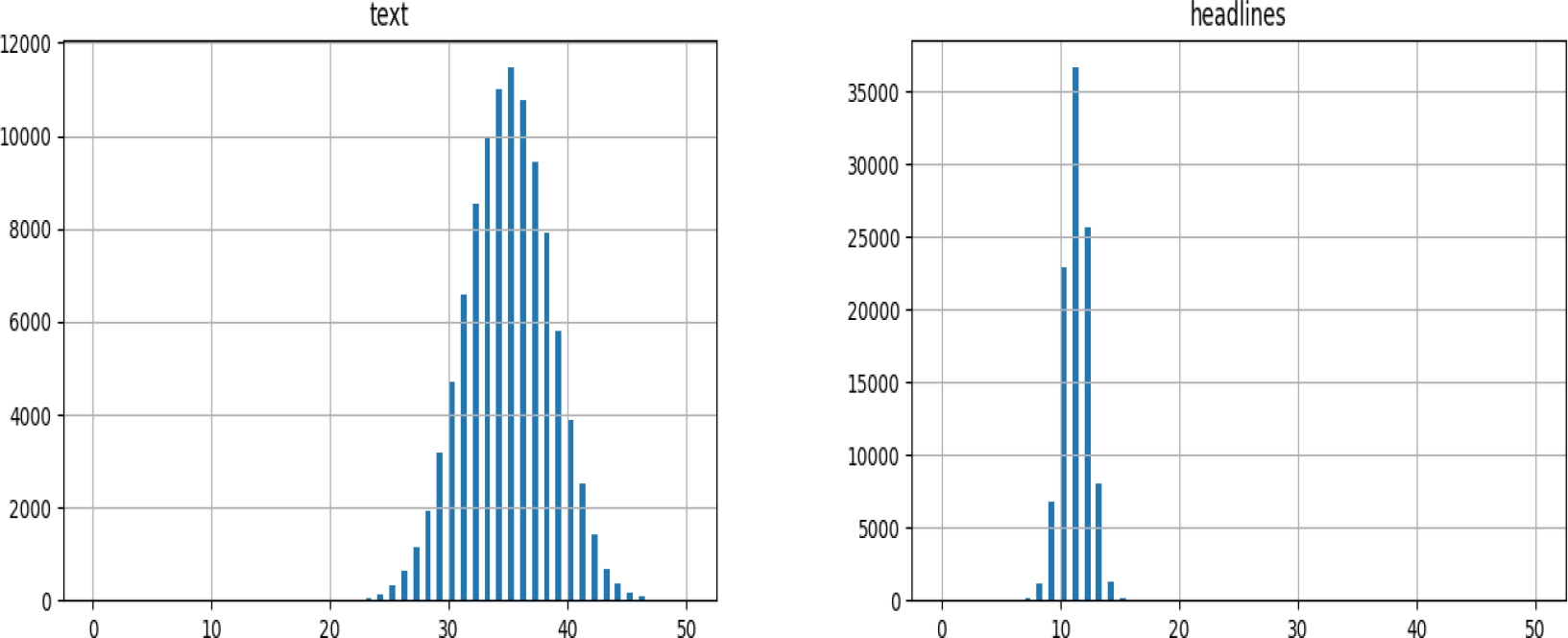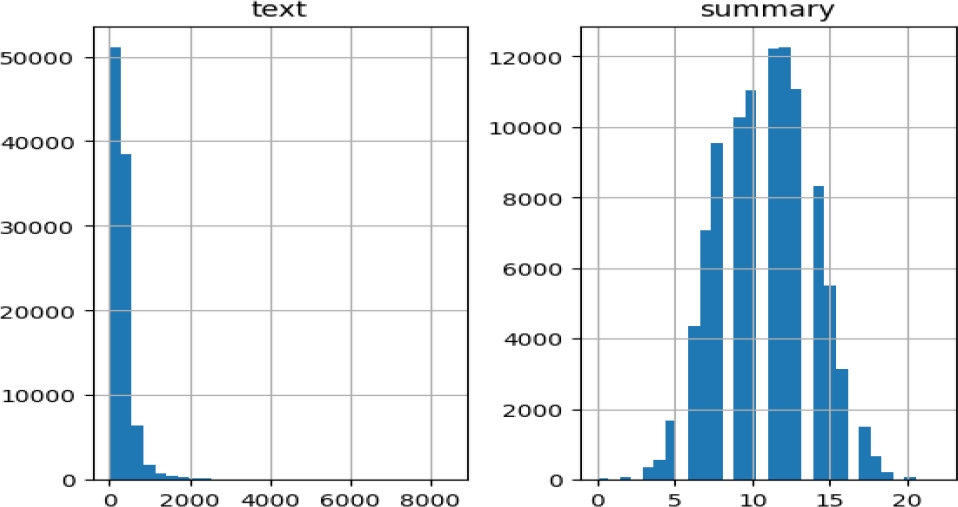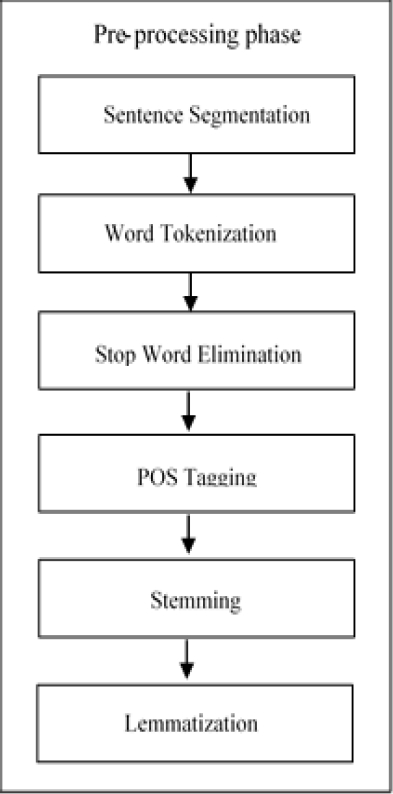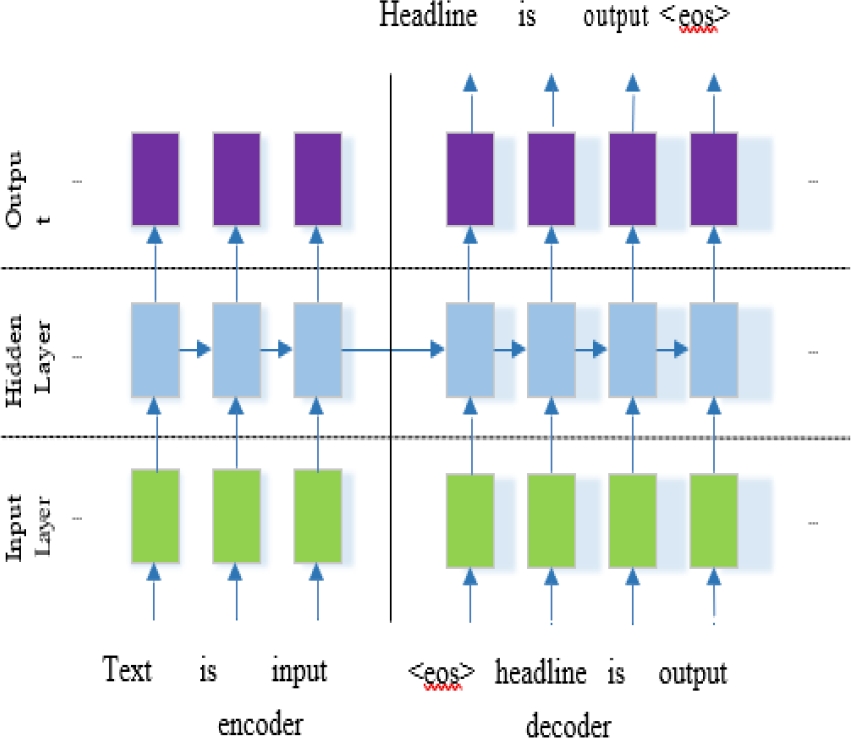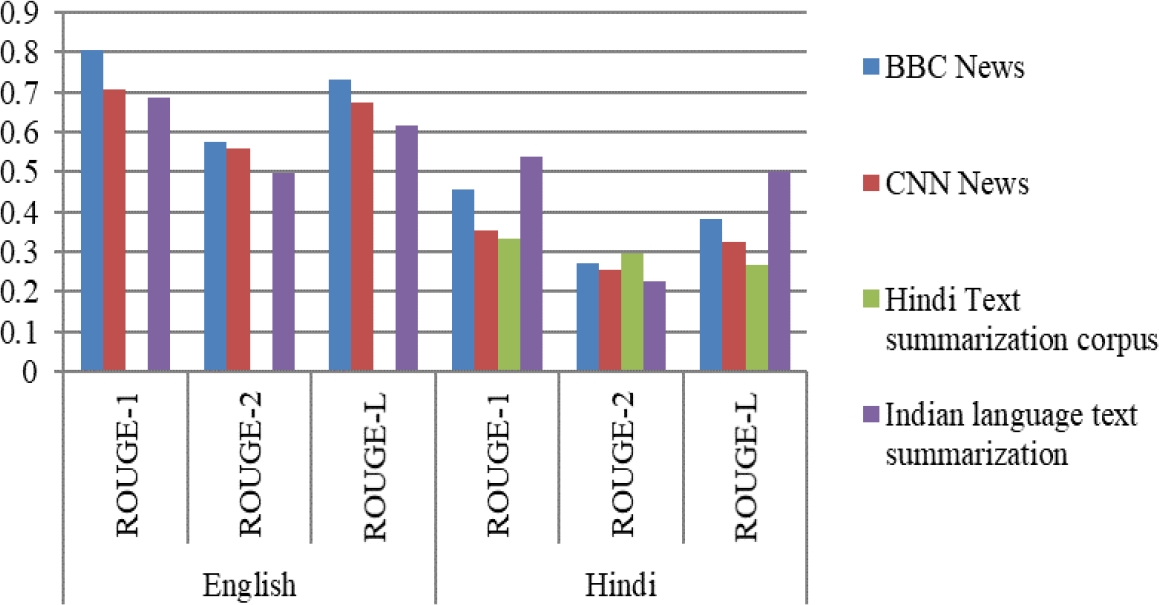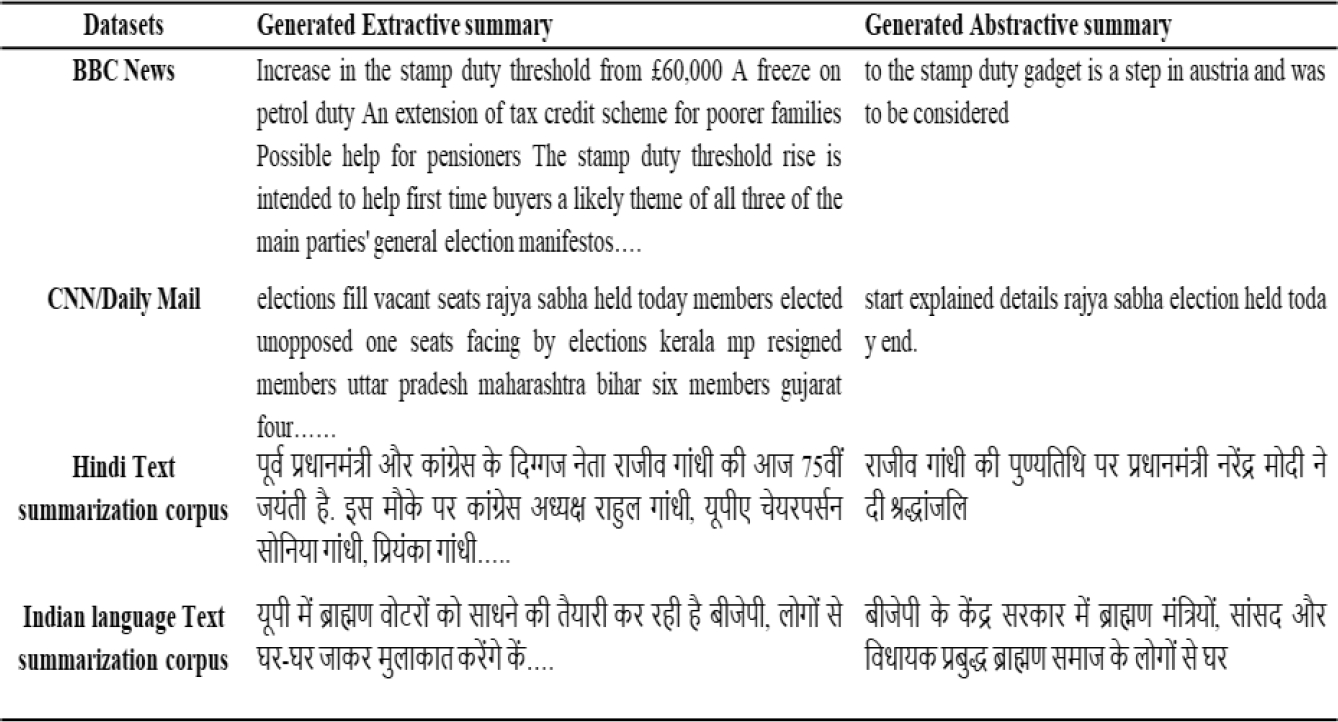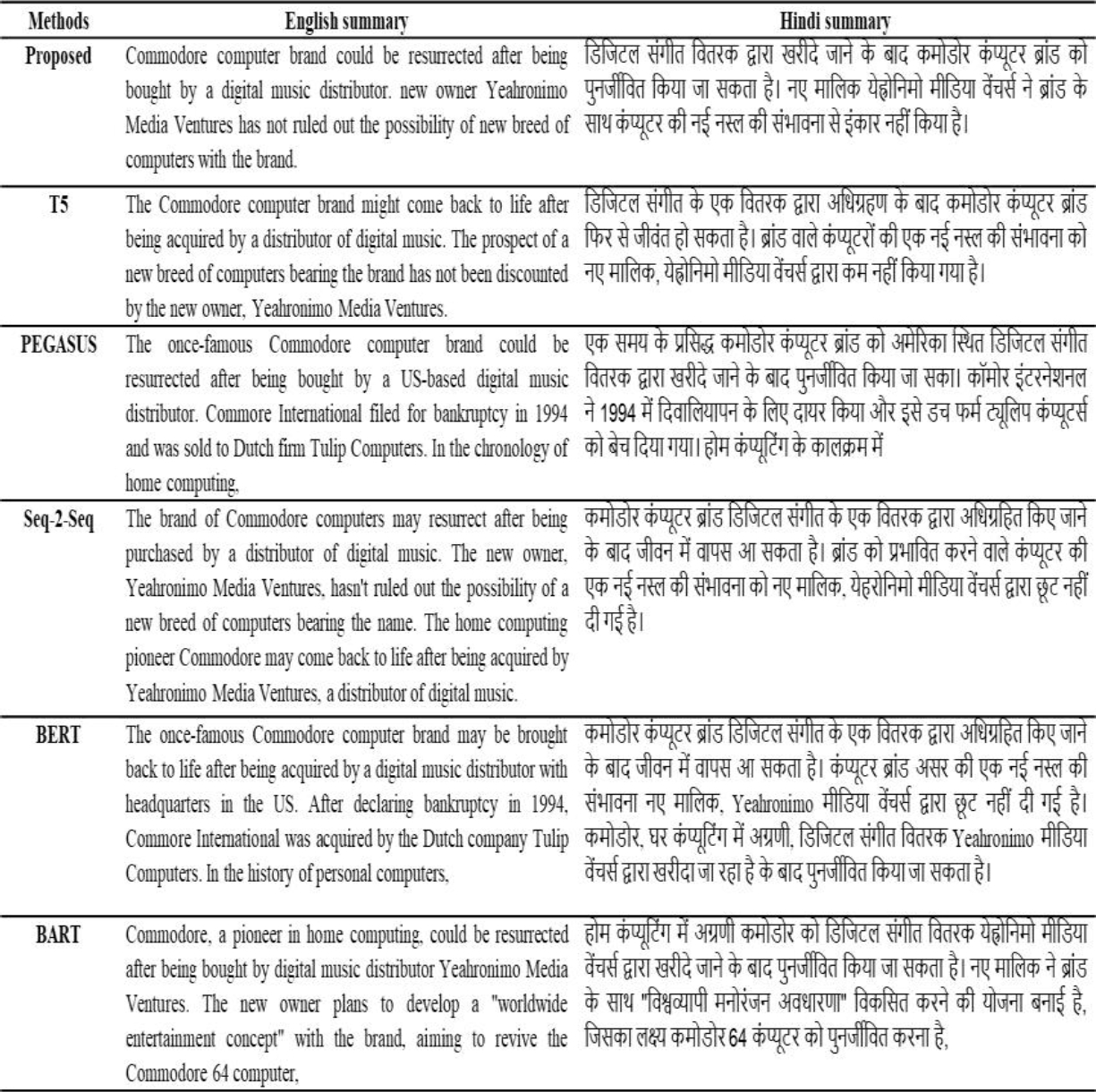1 Introduction
The development of automatic text summarization for Hindi documents faces various problems, including a lack of big training datasets, a lack of parallel corpus, exceptionally long document summary pairs with corresponding parallel text, and so on. [1] To resolve this issue, we introduce a sequence-to-sequence encoder-decoder approach that generates new sentences based on the extraction of relevant lines from a news article.
To create the summaries, we used documents in Hindi and English. We use an RNN model to execute the sequence-to-sequence task in extractive summarization. Figures 1 and 8, respectively, depict the architectures of the proposed extractive and abstractive text summarizing techniques. In extractive text summarization, encoders read documents, whereas decoders extract sentences from the input document.
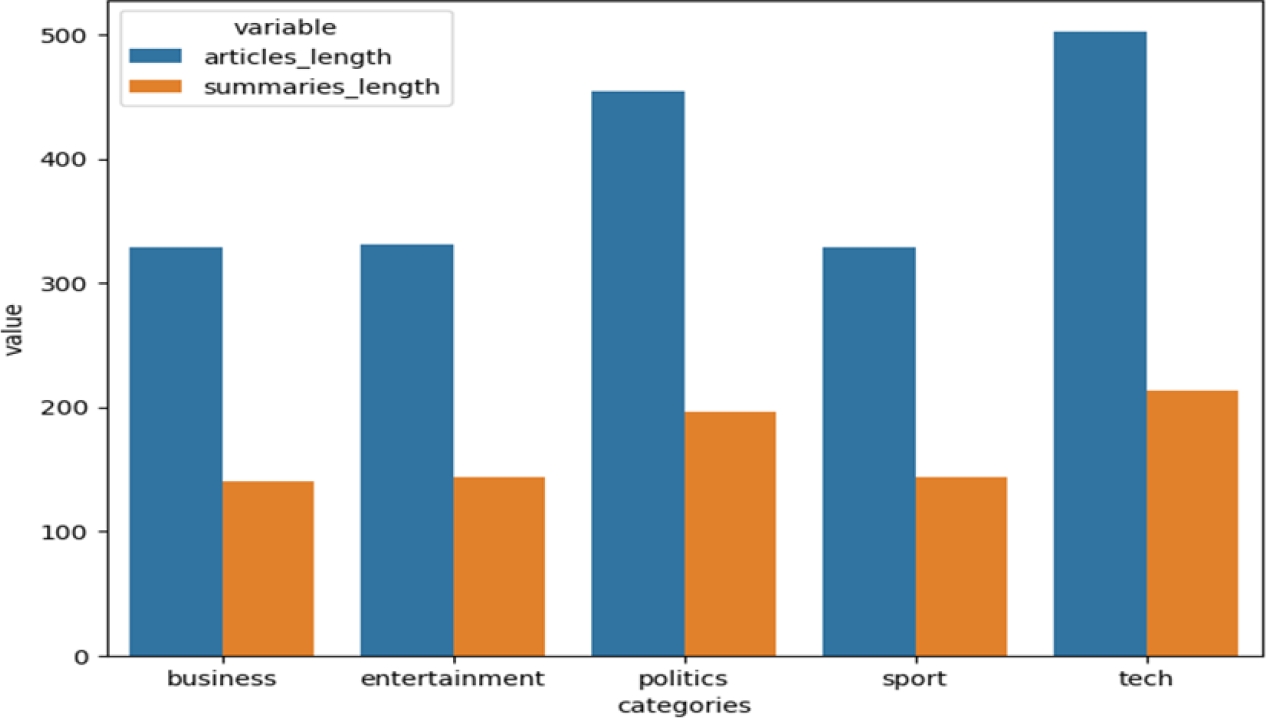
Fig. 2 Pictorial representation for length of the articles and summaries for BBC English dataset with individual categories
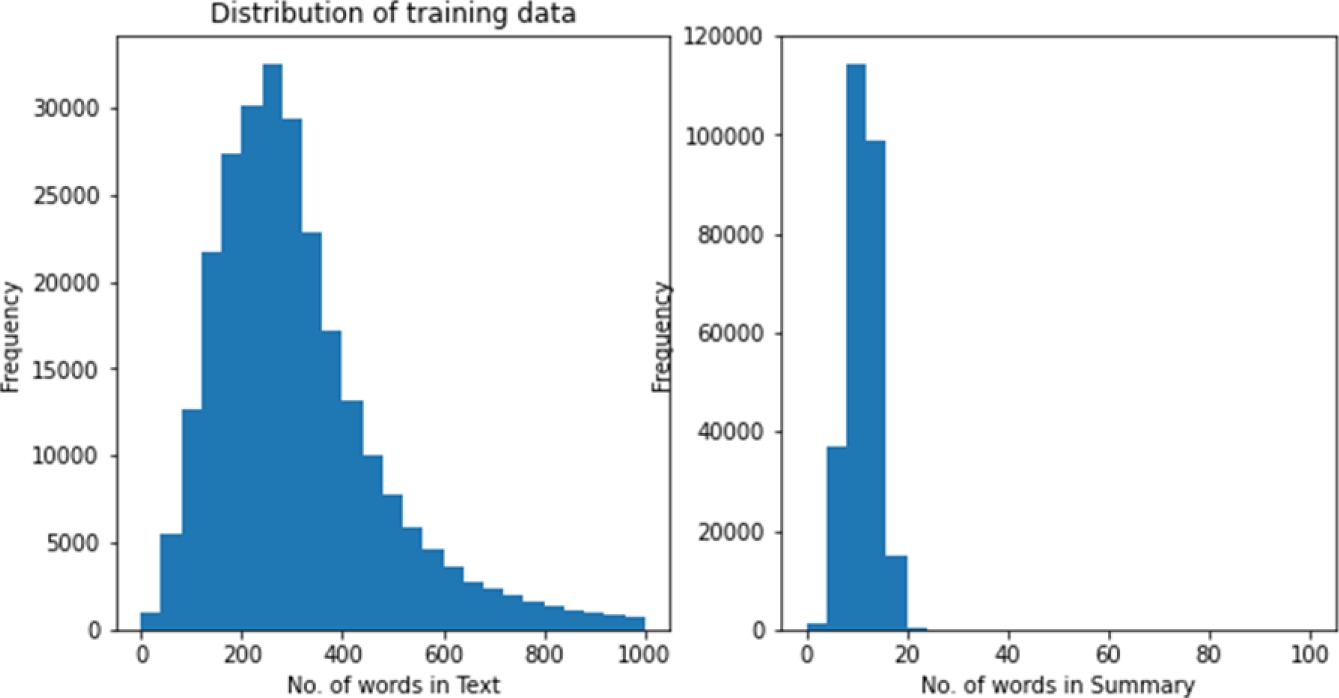
Fig. 3 Distribution of training data and number of words in summary for Hindi text summarization dataset

Fig. 4 Distribution of testing data and number of words in summary for Hindi text summarization dataset
We use the extractive summaries as input to generate abstractive summaries, utilizing natural language generation techniques. We perform abstractive summarization on Hindi texts from two major news datasets, BBC News and CNN News, to train our model.
We tested using two different Hindi datasets: the Hindi text summarization corpus dataset and the Indian language text summarization corpus dataset. The BBC News and CNN News datasets are in English, so we translated them into Hindi using three open-source machine translators: Microsoft Bing, Google, and Systran. The Seq2Seq model is the fundamental approach for generating abstractive summaries in English; however, it is more difficult in Hindi.
The encoder-decoder architecture solves the challenge of abstractive text summarization. This approach feeds an input document into an encoder, which then outputs an RNN model to generate the summary. We built the initial encoder-decoder model using the Seq2Seq approach [2]. Using a trained model, we implement a heuristic by re-ranking every sentence in a document according to its likelihood of being a summary sentence. We rank the results produced by N-gram language models using RNN.
Furthermore, we conducted a comparison between our results and those of other studies that used CNN and BBC datasets for processing. Although extracting summaries has been the focus of several studies, the current research contrasts with some of the most recent automatic text summary methods that have produced superior outcomes. We make comparisons with other current transformers, including PEGASUS [27], BERT [22], BART [26], and T5 [23].
The main contributions of this research are as under:
– We introduce a deep learning-based extractive and abstractive text summarization architecture for Hindi and English text documents.
– To summarize a news article, we employed a sequence-to-sequence encoder-decoder model using RNN. First, we extracted the key sentences for extractive summaries, and then we generated new sentences for abstractive summaries.
– Through experiments, we demonstrate that the proposed method outperforms other current methods and fundamental systems. The proposed method obtains a notable performance boost on the CNN News dataset, the BBC News dataset, the Hindi Text Summarization Corpus dataset, and the Indian language text summarization corpus dataset.
2 Literature Review
The use of extractive text summarization in deep neural network (DNN) information processing has gained popularity. These machine learning techniques integrate numerous nonlinear neural network (NN) layers. To function well, the DNN requires a large amount of training data.
For example, the development of DNNs such as recurrent neural networks (RNN) and convolutional neural networks (CNN) requires enormous datasets. Abstractive summary methods require NLP, machine learning, and deep learning methods [3, 8, 21] to generate and select meaning words to form new sentences.
Other recent abstractive methods are Pointer Generator [17], Pre-Training with Extracted Gap-Sentences for Abstractive Summarization (PEGASUS) [27], and T5 [23]. Nowadays, abstractive text summarization is based on a neural network that produces a neural sequence-to-sequence model. A hybrid pointer-generator network model uses this model on various datasets, including CNN and the Daily Mail.
The PEGASUS model is a newly proposed Google model for pre-training large corpora via a transformer-based encoder-decoder model [27]. There are two key graph-based methods that yield promising results for sentence ranking: TextRank [42] and LexRank [43].
For the Indian language, these methods are domain- and language-independent [44]. Both methods select words or phrases from an input document and position them as vertices in a weighted, undirected network. Edges are then drawn between sentence pairs according to how similar they are to each other.
The main difference between TextRank and LexRank is that they measure the similarity between two sentences. TextRank measures the similarity based on the similar words between two sentences, and LexRank measures the similarity by using cosine similarity.
The Google search engine uses the PageRank [45] algorithm in both methods to rank webpages and select important phrases through a random walk across a network.
Tables 1 and 2 describe previous work in extractive and abstractive text summarization based on datasets, approaches, methods, and challenges [3]. In the previous year's study, many researchers created summarizer models to generate understandable automatic text summaries. The majority of extractive text summarization uses machine learning techniques. Machine learning is considered one of the most effective techniques in most studies due to its ability to generate modern parameters.
Table 1 A comparison based on dataset, techniques, methods, and problem of extractive text summarization
| Research | Year | Techniques | Methods | Challenges |
| Ren et al.,[8] | 2016 | ML | CNN | Sentence Scoring |
| Gulati et al.,[9] | 2016 | ML | Fuzzy logic | Extraction |
| Wu et al.,[10] | 2017 | ML | LDA | Topic modeling |
| Nalik et al., [5] | 2017 | Rule Based | Rule Based | Extraction |
| Fang et al., [7] | 2018 | ML | Co-rank | Sentence Ranking |
| Khan et al., [6] | 2019 | ML | TF-IDF and K-Means | Extraction |
| Lierde et al., [4] | 2019 | Statistic | Fuzzy hyper graph | Semantic |
| Alami et al., [11] | 2021 | ML | MMR | Semantic |
Table 2 A comparison based on dataset, techniques, methods, and problem of abstractive text summarization
| Research | Year Dataset | Techniques | Methods | Challenges |
| Chopra et al., [14] | 2016 DUC | DL | CNN | Long Sequences |
| Nallapati et al., [15] | 2016 Gigaword, CNN/DM | DL | GRU-RNN | Unknown Words |
| Zeng et al., [16] | 2016 Gigaword, DUC | DL | GRU LSTM | Large Vocabulary |
| See et al., [17] | 2017 CNN/DM | DL | Bidirectional LSTM-RNN | Repeated Statements |
| Cao et al., [18] | 2018 Gigaword | DL | Bidirectional GRU | Generating Summaries with Fake Facts |
| Sahoo et al., [13] | 2018 DUC 2002 | ML | Markov and SVM | Sentence Scoring |
| Azmi et al., [12] | 2018 Arabic | Statistic | TF-IDF and NLP | Ambiguity |
| Zhang et al., [19] | 2019 Gigaword, CNN/DM | DL | CNN | Sequential Nature of RNNs |
In the last ten years, researchers have employed word embedding, TF-IDF, SVM, K-means, Markov, and MMR (maximal marginal relevance) techniques. A lot of researchers will utilize both machine learning and deep learning to summarize abstract language.
Most of the research on abstractive text summarization has used deep learning algorithms like RNN, CNN, GRU, LSTM, bidirectional LSTM-RNN, and bidirectional GRU to create short summaries of short text documents on well-known datasets like XSUM, DUC, CNN/DM, and CNN. In the current study, generative tasks are utilized to produce abstractive summaries known as pre-trained language models (PTLMs).
These models have a comprehensive semantic and contextual set of features that serve to improve the readability and relevance of the generated summaries. Table 3 compares various existing and popular pre-trained language models based on datasets and methodologies, such as ELMos, BERT, T5, BART, and PEGASUS.
Table 3 A comparison of abstractive text summarization related PTLMs
| PTLMs | Year | Dataset | Methods |
| GPT [20] | 2018 | Book Corpus | Language modeling (LM) |
| ELMOs [21] | 2018 | One-Billion-Word | Bidirectional LM |
| BERT [22] | 2019 | English Wikipedia | Masked LM |
| T5 [23] | 2019 | C4 | Masked Seq2Seq LM |
| UniLM [24] | 2019 | English Wikipedia etc. | Multi-task Seq2Seq masked LM |
| MASS [25] | 2019 | - | Masked Seq2Seq LM |
| BART [26] | 2020 | English Wikipedia etc. | Denoising auto-encoder |
| PEGASUS [27] | 2020 | C4, HugeNews | Masked LM |
| Prophetnet [28] | 2020 | English Wikipedia etc. | Future n-gram prediction |
| UniLMv2 [29] | 2020 | English Wikipedia etc. | Seq2Seq masked LM and Bidirectional LM |
| BigBird Pegasus [31] | 2020 | Big patents | Masked LM |
| Switch-C [30] | 2021 | Improved C4 | Masked LM |
| Pegasus-X [32] | 2022 | XSUM, CNN/DM | Long input summarization |
| Switch Transformers (FFN) [33] | 2022 | Colossal Clean Crawled Corpus | T5-base and T5-large based |
The results of text summaries, whether generated by machines or by humans, must be evaluated. However, the lack of a common evaluation criteria and the widespread usage of different criteria have made it challenging to evaluate text summaries.
For text summarization, two evaluation parameters are used: automatic evaluation and human evaluation. In automatic evaluation, the system’s performance is measured by using the very popular metrics of ATS, i.e., ROUGE [40].
In human evaluation of text summarization, the human judgements of different quality metrics such as readability, structure, and coherence, grammatically, referential clarity, content coverage, conciseness, and non-redundancy were computed.
3 Proposed Work
The proposed extractive approach acquires input text documents and applies text pre-processing to these texts. Once pre-processing is done, the most important features from the sentences, such as word embedding, TF-IDF, and bag-of-words, will be extracted as part of the feature extraction procedure. The datasets are trained using the Seq2Seq encoder-decoder model after word embedding. Figure 1 illustrates the proposed extractive text summarization approach and Figure 8 depicts the abstractive model using RNN.
3.1 Dataset Collection, Dataset Description and Cleaning of Corpus
This section defines the data used in this research, including articles from newspapers and websites in Hindi and English that were used to create extractive summaries. These articles were gathered from a variety of state-of the-art datasets, including BBC Newsfn, CNN/Daily-Mail Newsfn, in English language.
Three open-source translators such as Microsoft Bing translatorfn, Google translatorfn, and Systran translatorfn [34] which are all freely available online, translated them into Hindi. We have perfromed on all three translators, but we have only take the Google translated sentences for generating the extractive Hindi summaries. Beacause of high performance, the Google translator gives the highest results in all evaluation metrics [35].
Hindi text short summarization corpusfn and Indian language text corpus datasetsfn are loaded from the kaggle; it contains only Hindi text documents. Figure 2 depicts the BBC news dataset, which contains the following subfields: business, politics, entertainment, sports, and technology. The BBC news dataset contains 2225 entries over five fields.
Since the lengths of the documents are set at roughly ten sentences each, the summary length that results comprises three to four sentences chosen from the documents that received the highest score. The CNN dataset contains 500 news stories, with 400 utilized for training and 100 for testing. The document's summary and length are aligned with the BBC dataset.
Only Hindi text documents are included in the Indian language news text summarization corpus dataset and the Hindi text short summarization corpus dataset, which are loaded from Kaggle. Since the document lengths for the Indian language text corpus (ILSUM) and Hindi text brief summarization corpus datasets have been determined at about 20 sentences each, the final summary length contains 10 sentences that were chosen from the documents that received the highest score.
The previous explanations outline how to use the Seq2Seq model to extract the key sentences for extractive text summarization. The abstractive text summarization's parameters and their values are listed in Table 4. The Seq2Seq model was run using the Google Collaboratory. The preceding datasets were separated into training and testing sets.
Table 4 Parameters and their values for abstractive text summarization
| Parameters | Value |
| Language | English, Hindi |
| Input description length | 100 words (English) 50 words (Hindi) |
| Output summary length | 30 words (English) 15 words (Hindi) |
| Learning rate | 0.01 |
| Batch Size | 8 |
| Epochs | 2 |
| Uniform distribution | from {-0.1,0.1} |
The proposed approach was tested with 10% of the data, while the remaining 90% was used for training. A tensor flow CPU version was used to construct our model. We propose an abstractive text summarizer for both English and Hindi text documents. There are many effective summarizers available in English. However, we have made a proposal to create an improved method for the same datasets in both languages.
We employed the encoder-decoder approach, with three layers in the encoder and three layers in the decoder, to train the proposed model. Word vector size and hidden state size are both 256 for training purposes. We have trained news datasets with appropriate articles and headlines by utilizing these factors.
Testing, validation, and training are all done with the datasets. The distributions of training and testing statistics for the Hindi text summarization dataset are displayed in Figures 3-4. For the Hindi text summarization dataset and the BBC News dataset, the text and generated summary are displayed in Figures 5 and 6, respectively.
3.2 Text Pre-Processing
In order to generate the summary, firstly we import an English input document from the Kaggle dataset and a Hindi document from the translated text files. As the result of different text being organized in unstructured forms on the internet, text pre-processing, which is necessary in many NLP applications, can be performed after accepting an input document.
Given that it contains noise in many forms, such as stop words, punctuation marks, emotions, and distinct text instances, handling it in a language with limited resources like Hindi is an extremely difficult challenge. As a result, text pre-processing is necessary to make the text corpus cleaner.
Text pre-processing will be carried out in multiple steps, including tokenizing sentences, tokenizing words, removing punctuation, eliminating stop words, stemming, and lemmatization, as demonstrated in Figure 7. Sentences are divided into separate sentences and saved with their respective sentence positions during sentence tokenization.
Word tokenization divides the split sentences into individual words. Punctuation marks and stop words from the extracted words from the input sentences will be eliminated. The NLTK stop words listfn was utilized for both Hindi and English text.
After stop word elimination, supervised statistical POS tagging will be used to assign the POS for each extracted word [36]. After POS tagging, stemming and lemmatization will be performed.
This work will be accomplished by using a lightweight stemmer, morphological analyzer, and rule-based stemmer [37]. Throughout the pre-processing stage, we utilized pre-trained models, including T5, BART, BERT, and PEGASUS, after the tokenization of words and sentences. The purpose of this is to make sure that the split text uses the same vocabulary from pre-training and correlates in the same way with the pre-trained model's corpus.
After finishing the pre-processing stage, sentence features can be extracted and the sentence score calculated. The sentences were analysed to determine sentence position, sentence length, TF-IDF, i.e., term frequency-inverse document frequency score, bi-gram and tri-gram scores, scores, and other metrics.
When these features are calculated, they produce a sentence matrix. These feature values will be sent to the training model. To improve our model, we applied a pre-trained word to a vector file named GloVe (Global Vectors for Word Representation).
3.3 Seq2Seq Model
The Seq2Seq Model's encoder layer will receive and handle these feature values. The Seq2Seq model's architecture is made up of two main components: the encoder and the decoder, both of which are RNN [38].
The encoder receives the text of the news article one word at a time. Each word is first transformed into a distributed representation by passing through an embedding layer.
A multi-layer neural network is then used to integrate this dispersed representation, which includes either all 0s for the first word in the text or the hidden layers formed after feeding in the prior word, as shown in Figure 8.
The decoder receives the final word of the input text and uses the newly generated hidden layers as input. An embedding layer is employed to convert the input EOS, i.e. end-of-sequence symbol back into a distributed representation. The decoder then generates text summaries for each word in the headline using a SoftMax layer and the attention mechanism described in the following section, before terminating with an end-of-sequence symbol.
Each word is formed, and the exact same word is used as the input for the next word. Some new special tokens, such as <UNK> and <EOS> have been introduced to the lexicon. Due to limited vocabulary few words are still in use. UNK defines the token takes the place of those words [39].
The end of the sequence, which the EOS token contains, signals the encoder when it receives input. SoftMax regression and multiclass classification both are used for calculating the loss of categorical cross entropy. We have calculated cross entropy loss by equation 1, where Y is the real value and K is the total number of classes in the dataset:
3.4 Summary Generation
We generate a summary after implementing the sequence-to-sequence model. We thus execute the model in the deep learning framework in order to generate the summaries. About 10 minutes are required for the Google Colab GPU accelerator to train the text documents. In order to train the model, we set a minimum batch size because training stops if the batch size is too large. Our model is trained over two epochs. Using our model, we have produced a summary after the training phase has been completed.
3.5 Summary Evaluation
The proposed method for developing summaries in Hindi and English has been evaluated using ROUGE (Recall Oriented Understudy for Gisting Evaluation) [40].
We will also utilize several evaluation metrics, including as precisión, recall, and F-measure, wich have previously been used to evaluated summaries in Hindi English.
These evaluation metrics are considered standard performance indicators for a system.
These metrics were computed using the equations (2), (3), and (4):
To determine the ROUGE score, an N-gram score was produced, which is based on word and sequence overlap between the suggested summary and the reference summary, where N is the length of the document's N-grams (1, 2, 3, etc.).
We calculated three ROUGE scores for English and Hindi summaries: ROUGE-1, ROUGE-2, and ROUGE-L. The ROUGE-1, ROUGE-2, and ROUGE-L metrics are used to determine the similarity of unigrams, bigrams, and the longest common subsequence (LCS), respectively.
For comparison, we calculated the cosine similarity between the generated summary and the reference summary for extractive text summarizing. Equation (5) defines cosine similarity, which is utilized to compute content-based similarity metrics for generated summaries:
where S1, S2 stands for the sentence's vectors. It is predicated on how the sentences overlap one another using a vector space model. Sentence rating is done after the similarity score is calculated, and the output summary consists of the sentences which are ranked highest [41].
4 Results and Discussions
The proposed model includes hyperparameters that are customized to the specific data set. The presented model incorporates hyper-parameters into both the label generation and summary generation stages. When the stored model is at its lowest loss factor, a call-back function is used to checkpoint the model after each epoch to see if the loss function has improved since the last best-saved instance.
For extractive text summarization in Hindi, Tables 5 and 6 define the different ROUGE scores of the proposed and other baseline approaches on BBC News, CNN News, the Hindi text summarization corpus, and ILSUM. It is obvious that the proposed method performs better overall than various methods like TextRank, LexRank, Lead, Luhn, LSA, and SumBasic. Figures 9 and 10 show the comparative analysis of different ROUGE scores between all the datasets. For extractive text summarization, TextRank and LSA yield the second-best results.
Table 5 Compare ROUGE scores between proposed and other SOTA approaches on BBC News and CNN News datasets for extractive text summarization
| BBC News dataset | CNN News dataset | |||||
| Approach | ROUGE-1 | ROUGE-2 | ROUGE-L | ROUGE-1 | ROUGE-2 | ROUGE-L |
| TextRank | 0.86 | 0.83 | 0.81 | 0.56 | 0.42 | 0.49 |
| LexRank | 0.78 | 0.73 | 0.75 | 0.45 | 0.3 | 0.39 |
| Lead | 0.77 | 0.73 | 0.74 | 0.61 | 0.51 | 0.52 |
| Luhn | 0.8 | 0.76 | 0.77 | 0.5 | 0.36 | 0.42 |
| LSA | 0.86 | 0.83 | 0.82 | 0.5 | 0.34 | 0.43 |
| SumBasic | 0.7 | 0.62 | 0.68 | 0.48 | 0.32 | 0.38 |
| Proposed | 0.89 | 0.84 | 0.82 | 0.65 | 0.56 | 0.58 |
Table 6 Compare ROUGE scores between proposed and other SOTA approaches on Hindi text summarization corpus and ILSUM dataset for extractive text summarization
| Hindi Text summarization corpus dataset | Indian language text summarization dataset | |||||
| Approach | ROUGE-1 | ROUGE-2 | ROUGE-L | ROUGE-1 | ROUGE-2 | ROUGE-L |
| TextRank | 0.71 | 0.63 | 0.69 | 0.57 | 0.29 | 0.52 |
| LexRank | 0.63 | 0.53 | 0.63 | 0.52 | 0.31 | 0.47 |
| Lead | 0.62 | 0.53 | 0.62 | 0.53 | 0.31 | 0.5 |
| Luhn | 0.65 | 0.56 | 0.65 | 0.52 | 0.31 | 0.46 |
| LSA | 0.71 | 0.63 | 0.7 | 0.53 | 0.31 | 0.5 |
| SumBasic | 0.55 | 0.42 | 0.56 | 0.49 | 0.27 | 0.45 |
| Proposed | 0.74 | 0.64 | 0.7 | 0.62 | 0.37 | 0.54 |
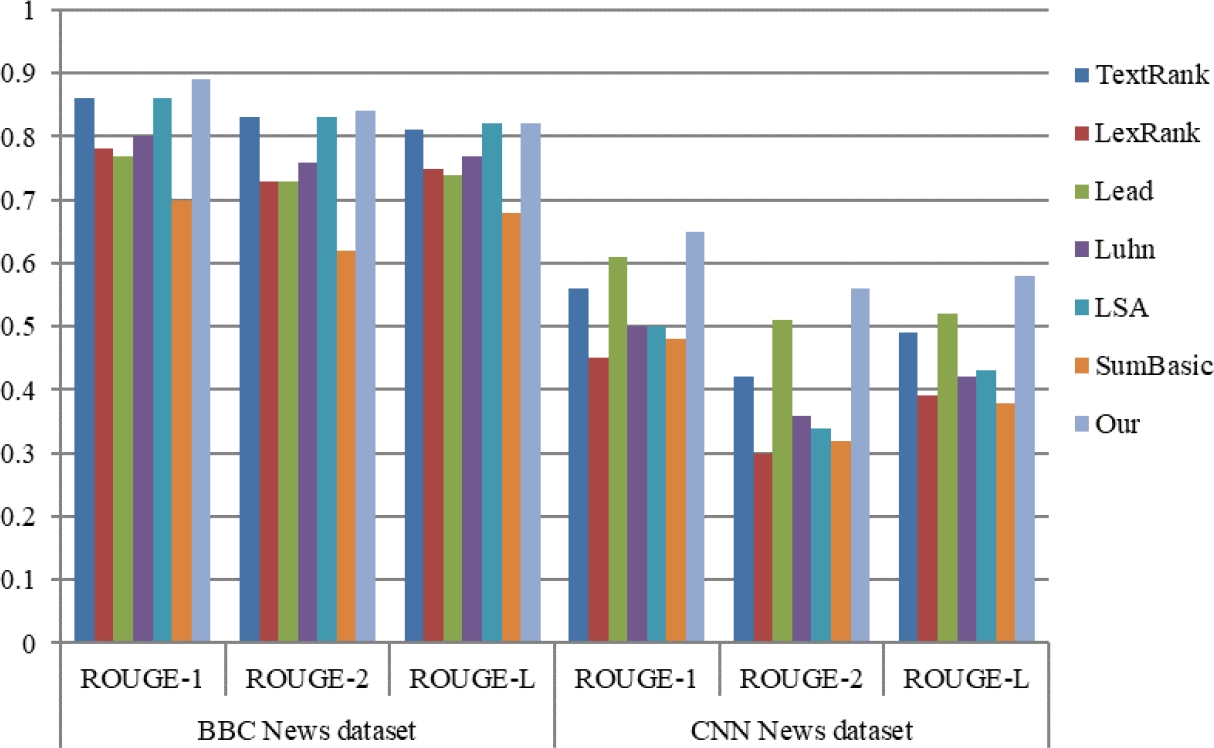
Fig. 9 ROUGE based comparison of proposed and other baseline approaches on BBC News and CNN News dataset for extractive text summarization
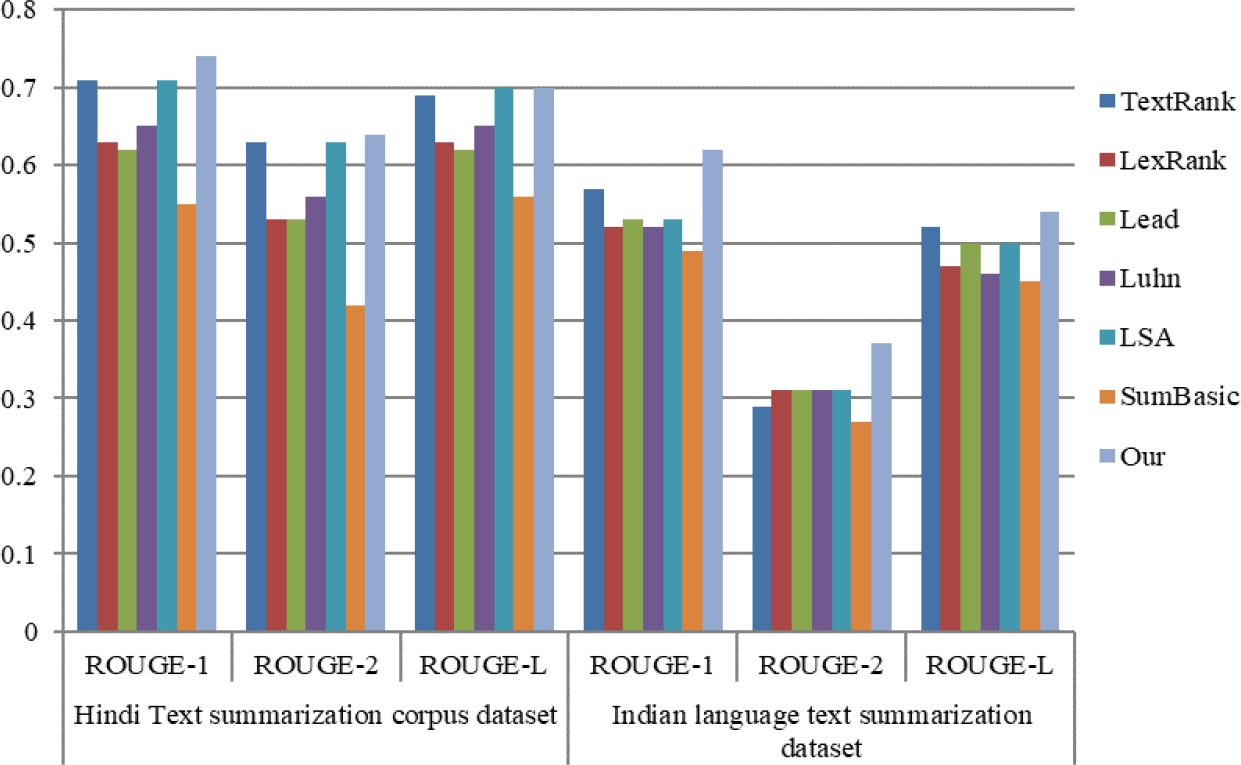
Fig. 10 ROUGE based comparison of proposed and other baseline approaches on Hindi text summarization corpus and ILSUM dataset for extractive text summarization
For abstractive text summarization, Table 7 defines the different ROUGE scores of the proposed approach in English and Hindi with respect to BBC News, CNN News, the Hindi text summarization corpus, and the ILSUM dataset.
Table 7 ROUGE score for different datasets for Abstractive text summarization
| Datasets | English | Hindi | ||||
| ROUGE-1 | ROUGE-2 | ROUGE-L | ROUGE-1 | ROUGE-2 | ROUGE-L | |
| BBC News | 0.80677 | 0.57429 | 0.73269 | 0.45556 | 0.27308 | 0.38148 |
| CNN News | 0.70576 | 0.55746 | 0.67545 | 0.35455 | 0.25625 | 0.32424 |
| Hindi Text summarization corpus | _ | _ | _ | 0.33333 | 0.2963 | 0.26667 |
| Indian language text summarization | 0.68454 | 0.49604 | 0.61788 | 0.53692 | 0.22528 | 0.50121 |
The absence of the Hindi text summarization dataset in English is indicated by the blank score. Figure 11 shows the comparative analysis of different ROUGE scores between all the datasets. The results indicate that the English BBC News dataset has the highest ROUGE score of all the datasets; the Hindi ILSUM dataset has the highest ROUGE-1 and ROUGE-L scores; and the BBC dataset has the highest ROUGE-2 score.
The complete ROUGE scores for the CNN, BBC, and Hindi text summarization and ILSUM datasets are displayed in Tables 8 and 9, respectively. Similarly, the suggested method outperforms all other ROUGE scores across all datasets. The comparable results for the ILSUM dataset with ROUGE-1 and ROUGE-L are provided by Sequence to Sequence and T5. The comparative evaluation of the various ROUGE scores for Hindi across all datasets is displayed in Figures 12 and 13.
Table 8 ROUGE score for multiple existing approaches of abstractive text summarization for BBC and CNN datasets in Hindi
| Methods | BBC News dataset | CNN News dataset | ||||
| ROUGE-1 | ROUGE-2 | ROUGE-L | ROUGE-1 | ROUGE-2 | ROUGE-L | |
| Sequence-to-Sequence | 0.41 | 0.33 | 0.32 | 0.27 | 0.08 | 0.09 |
| BERT | 0.25 | 0.22 | 0.20 | 0.21 | 0.04 | 0.17 |
| BART | 0.14 | 0.10 | 0.17 | 0.11 | 0.04 | 0.08 |
| PEGASUS | 0.28 | 0.15 | 0.18 | 0.26 | 0.04 | 0.23 |
| T5 | 0.34 | 0.28 | 0.34 | 0.41 | 0.19 | 0.30 |
| Proposed | 0.66 | 0.61 | 0.37 | 0.67 | 0.56 | 0.59 |
Table 9 ROUGE score for multiple existing approaches of abstractive text summarization for Hindi Text Summarization Corpus and ILSUM datasets
| Methods | Hindi Text summarization corpus dataset | ILSUM dataset | ||||
| ROUGE-1 | ROUGE-2 | ROUGE-L | ROUGE-1 | ROUGE-2 | ROUGE-L | |
| Sequence-to-Sequence | 0.39 | 0.27 | 0.19 | 0.27 | 0.05 | 0.05 |
| BERT | 0.27 | 0.16 | 0.24 | 0.11 | 0.01 | 0.11 |
| BART | 0.18 | 0.05 | 0.09 | 0.09 | 0.03 | 0.07 |
| PEGASUS | 0.50 | 0.32 | 0.46 | 0.18 | 0.00 | 0.49 |
| T5 | 0.31 | 0.32 | 0.38 | 0.23 | 0.15 | 0.27 |
| Proposed | 0.59 | 0.34 | 0.56 | 0.27 | 0.22 | 0.25 |
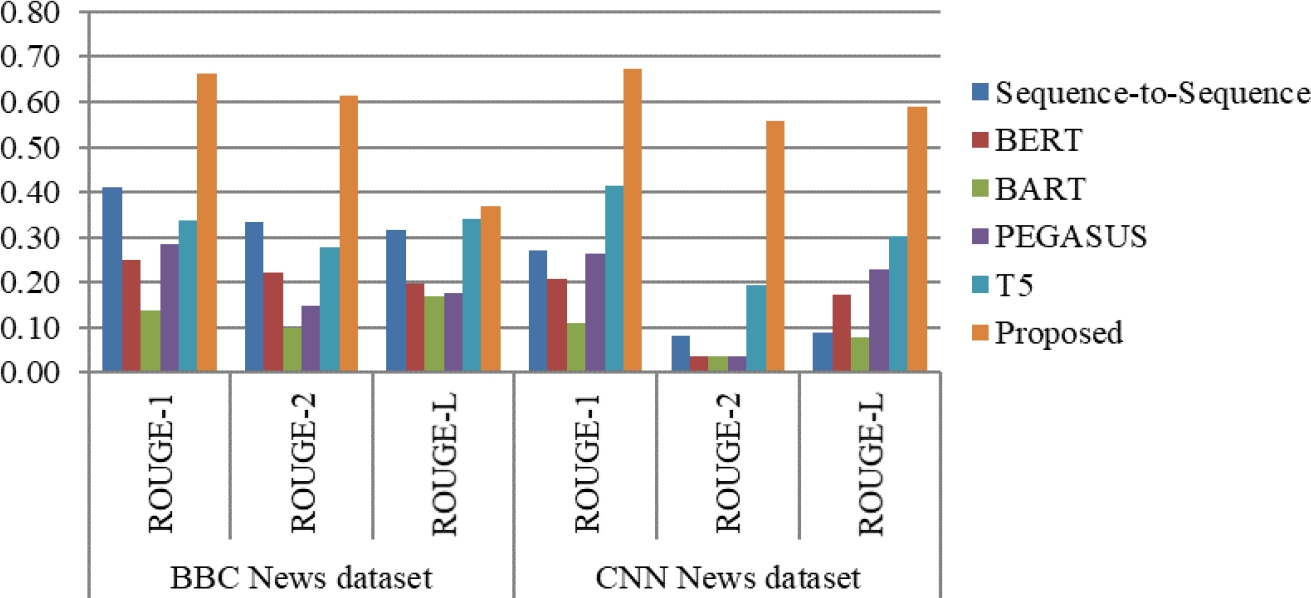
Fig. 12 ROUGE score for multiple existing approaches of abstractive text summarization for BBC and CNN datasets in Hindi

Fig. 13 ROUGE score for multiple existing approaches of abstractive text summarization for Hindi Text Summarization Corpus and ILSUM datasets
Figure 14 shows an example of a summary produced by the proposed approach for each of the input datasets. The comparison of the generated summaries with other current methods is shown in Figure 15. A document from the BBC dataset was used as a comparison, and summaries for each method were produced. This result shows the generated summaries, and the reference summary is most likely comparable.
5 Conclusions
In this paper, we present an approach for extractive and abstractive text summarization based on deep learning techniques, specifically the Seq2Seq model with RNN. We used this model to summarize the text document in both English and Hindi. The proposed method relied on translated text sources because Hindi datasets were unavailable.
We retrieved word embedding linguistic feature scores from each document and got the sentences for summary generation. The proposed study has been evaluated using different ROUGE metrics, such as ROUGE-1, ROUGE-2, and ROUGE-L. Also, we have computed other parameters, including precisión, recall, and f-measure, across several datasets.
We used four different datasets, including BBC News articles and CNN News, to give summaries in English as well as in Hindi. We also employed two datasets containing exclusively Hindi documents: the Hindi Text Short Summarization Corpus and the ILSUM dataset.
We compared our methods to state-of-the art text summarization techniques such as TextRank, LexRank, Lead, Luhn, and SumBasic algorithms for extractive text summarization.
For abstractive text summarization, we have compared the proposed results with existing deep learning techniques such as sequence-to-sequence, BERT, BART, PEGASUS, and T5 transformers. The results clearly demonstrate the effectiveness of the proposed methodology in Hindi as well as in English text summaries.











 nueva página del texto (beta)
nueva página del texto (beta)


